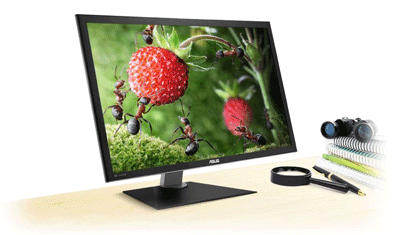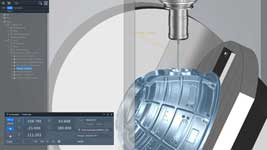Monitors for the CAD workstation
- Details
- Hits: 10204

In addition to a high-performance PC and corresponding CAD / CAM software, professional displays are the basic equipment of a designer or designer. Because the success or failure of a design decides not least the visual impression of the viewer. Whether a solo artist or a team player is preferred - with the advent of new technologies and devices such as powerful zero client monitors and the latest 4K monitors, CAD users have not only been increasing the number of options available in recent years. Which these are, explains the following contribution from Asus.
 Of course, until now, every simple, two-dimensional drawing or every three-dimensional object up to computer animation has somehow been displayed. With the technical progress in the monitor area, however, the variety of options for designing the individual CAD workstation has increased enormously.
Of course, until now, every simple, two-dimensional drawing or every three-dimensional object up to computer animation has somehow been displayed. With the technical progress in the monitor area, however, the variety of options for designing the individual CAD workstation has increased enormously.
Of course, there are certain intrinsic values that will never go out of style in this environment. This includes an optimal representation of image and color. Models with IPS or VA panels are happy to comply with these requirements. They provide the graphics power required for the design engineer, including a stable view, so that in the case of short meetings in the circle of colleagues, the sideways employee can also see everything. When it comes to color reproduction, it should be models with full SRGB color space coverage and maximum Adobe RGB color space coverage. The right values are already reached by semi-professional graphics monitors today. Also not to be despised is the contrast ratio, which can emphasize even the smallest nuances from a value of 1000: 1.
Great in format and details
Opinions often differ when it comes to the size and the associated resolution. Nowadays monitor sizes of 24 inches and above are becoming more and more popular for CAD workstations, but from this dimension onwards it should be a resolution beyond Full HD so that even small components can be staged well. For displays from 27 inches, the WQHD resolution with 2560 x 1440 pixels or even WQXGA resolution with 2560 x 1600 pixels are available. So neither sketches nor exploded views end up in visual chaos.
 CAD CAM software for single part and small series production
CAD CAM software for single part and small series production
For models from 27 inches upwards, it is worth taking a look at the newer 4K devices, which shine with four times the Full HD resolution of 3840 x 2160 pixels. Especially when looking at complex assemblies, such as an engine block or a gearbox for the car, none of the numerous details are lost. In addition to the solution as a single monitor, 4K models beyond 30 inches also offer another advantage - with them, users get a real alternative for multi-screen solutions.
Multi-screen solution does not have to be any more
 For users who like to work side-by-side on multiple monitors or stretch their objects and drawings across multiple screens, 4K models can be quite interesting, as a single device can replace four individual Full HD monitors. The viewer has the advantage of not having any disturbing frames between the four fields of view. In addition, if the total power consumption of these individual displays is extrapolated, an 4K monitor can also bring benefits here - not to mention the lack of mounting and cable clutter behind the table. The user also has the option of being able to rely on the true value of their monitor at all times, displaying 4K content in native resolution or switching to pixel-by-pixel 8 megapixel photos when needed.
For users who like to work side-by-side on multiple monitors or stretch their objects and drawings across multiple screens, 4K models can be quite interesting, as a single device can replace four individual Full HD monitors. The viewer has the advantage of not having any disturbing frames between the four fields of view. In addition, if the total power consumption of these individual displays is extrapolated, an 4K monitor can also bring benefits here - not to mention the lack of mounting and cable clutter behind the table. The user also has the option of being able to rely on the true value of their monitor at all times, displaying 4K content in native resolution or switching to pixel-by-pixel 8 megapixel photos when needed.
Of course, the conventional option with two or three monitors next to each other will continue to enjoy great popularity. If you pay attention to the appropriate panel quality and choose models with the smallest possible frame and multiple connections, you will get an excellent work basis on the table.
Zero clients for particularly sensitive data
 Whether distributed on a single screen or multiple displays - the displayed objects or models are stored on the local machine, they pose a security risk at any time. Especially when developing prototypes or exchanging highly sensitive data, this can quickly become a problem, if unauthorized people access it. Zero Client monitors provide a solution. Equipped with powerful panels, they deliver the image quality necessary for the work. In addition to the mouse and keyboard connected directly via USB and a digital drawing board that is often used in this area, the display is also the only device in the workplace. All programs and data are stored on a central server and transmitted to the display as a pure display device using fast transfer protocols such as Teradici's PCOIP protocol.
Whether distributed on a single screen or multiple displays - the displayed objects or models are stored on the local machine, they pose a security risk at any time. Especially when developing prototypes or exchanging highly sensitive data, this can quickly become a problem, if unauthorized people access it. Zero Client monitors provide a solution. Equipped with powerful panels, they deliver the image quality necessary for the work. In addition to the mouse and keyboard connected directly via USB and a digital drawing board that is often used in this area, the display is also the only device in the workplace. All programs and data are stored on a central server and transmitted to the display as a pure display device using fast transfer protocols such as Teradici's PCOIP protocol.
In addition to the security aspect, users also benefit from all the other advantages of such a server-based computing solution: less equipment needed for the individual workstations, thereby lower operating and energy costs and less maintenance, because the software is even centrally updated and now available to all users in the latest version.
The author Sebastian in het Panhuis is Country Product Manager LCD & Projector at Asus.
